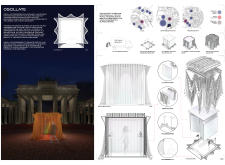5 key facts about this project
The conceptual framework of Oscillate is derived from the interplay of sound and movement, drawing inspiration from the rhythms of techno music. This approach not only informs the aesthetic language of the structure but also dictates its function as a site for performance, interaction, and engagement. The pavilion encourages active participation from users, inviting them to explore the space both individually and collectively.
Material and Structural Innovations
The use of dielectric glass in the walls allows for an interplay of light and color that changes with the external environment, enhancing the pavilion's connection to the urban surroundings. The craft of wooden waves is integrated into the roof structure, providing both aesthetic appeal and structural support. These materials are selected for their acoustic properties and their ability to create an inviting atmosphere.
The pavilion's design incorporates lightweight fabrics that define the edges, creating a sense of enclosure while still allowing transparency and visibility from the outside. These elements are not only functional but also strategically placed to encourage pedestrian flow, optimizing accessibility and engagement.
The architectural plans reveal that the layout is adaptable, easily transportable for different urban contexts, maintaining the versatility necessary for a temporary installation. The inclusion of assemblable shelves is notable, as they enhance the interactive capacity of the space by allowing users to engage with technology and information displays more effectively.
Engagement through Light and Sound
Oscillate distinguishes itself through its integration of dynamic lighting systems that enhance the user experience. These systems illuminate the pavilion in a way that reflects movement within the space, further connecting architecture with sound dynamics. The ambient illumination creates an inviting environment that attracts passersby while promoting communal interactions.
The pavilion serves not only as a physical structure but as a cultural touchpoint that resonates with visitors. Its location near historically significant landmarks like the Brandenburg Gate adds an additional layer of meaning, making Oscillate a contemporary comment on the relationship between urban heritage and modern artistic expression.
For those interested in a deeper exploration of Oscillate's architectural design, including architectural plans, sections, and overall architectural ideas, further details can be found in the project presentation. This enables an understanding of how the design integrates into its environment while addressing contemporary urban needs.























